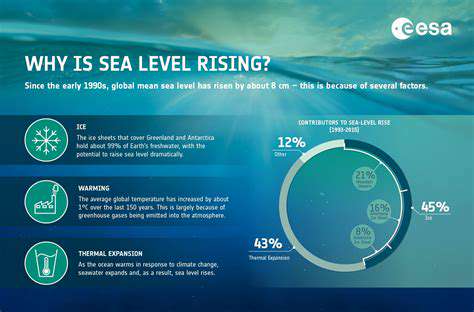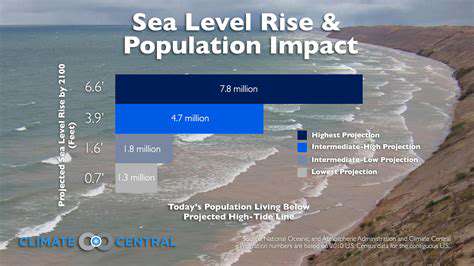Rising Sea Levels and Their Impact on Coastal Communities
The Causes Behind Rising Sea Levels

The Role of Climate Change
Climate change is a significant driver of rising sea levels. As global temperatures increase, polar ice caps and glaciers are melting at an alarming rate, contributing to higher ocean levels. This process not only affects marine environments but also poses serious threats to coastal communities.
Additionally, warmer temperatures lead to thermal expansion of seawater. As water warms, it expands, which further exacerbates rising sea levels. Coastal cities must prepare for the implications of these changes.
Countries across the world are feeling the impact of climate change-induced sea level rise. Vulnerable communities often lack the resources necessary to adapt, highlighting the need for immediate action and intervention.
Human Activities and Their Contribution
Human activities such as deforestation, urbanization, and fossil fuel consumption significantly contribute to rising sea levels. These activities increase greenhouse gas emissions, which trap heat in the atmosphere and lead to climate changes that affect sea levels. Deforestation, for instance, compromises natural defenses against erosion and flooding.
Urbanization often leads to the construction of infrastructure that can disrupt natural water drainage systems. This disruption has the potential to exacerbate flooding during storms and high tides. Protecting natural landscapes is crucial for maintaining the health of coastal ecosystems.
Moreover, the over-extraction of groundwater can lead to land subsidence in coastal regions. This further compounds the effects of rising sea levels, making some areas even more susceptible to flooding. Sustainable practices are necessary to mitigate these impacts.
The Social and Economic Consequences
The rising sea levels bring with them numerous social and economic challenges for coastal communities. Communities are facing increased flooding, which damages property and infrastructure. This can lead to financial losses and increased insurance costs for residents.
Moreover, the disruption of local economies, particularly those reliant on fishing and tourism, can be profound. In many cases, people may be forced to relocate, leading to loss of cultural identity and community ties. This displacement can create additional pressures on urban areas that may not have the capacity to accommodate new populations.
Finally, the strain on public services becomes increasingly evident as governments try to manage the impacts of rising sea levels. Effective planning and investment in resilient infrastructure are essential to minimize future social and economic crises.
The Impacts on Coastal Communities
The Physical Changes in Coastal Landscapes
As sea levels rise, coastal landscapes undergo significant transformations. Shoreline erosion becomes more pronounced, leading to the loss of land that communities have relied on for their homes, infrastructure, and recreation. Many beaches, once accessible to families, are washed away, and the natural habitats that exist in these areas are drastically altered.
Barrier islands, which serve as protective buffers for the mainland, are increasingly at risk. These islands can become inundated, losing their ability to shield coastal areas from storm surges and extreme weather events. As a result, vulnerable ecosystems and wildlife face unprecedented changes, which can strain local biodiversity.
Moreover, changes in sediment deposition patterns also occur, altering how coastlines evolve. The absence of significant landforms can exacerbate flooding in surrounding areas, requiring communities to rethink their planning and management approaches to protect their infrastructure.
Economic Consequences for Coastal Populations
Rising sea levels have severe economic implications for coastal communities, particularly those dependent on tourism, fisheries, and maritime industries. As beachfront properties and other valuable real estate become threatened, property values may plummet, resulting in financial losses for homeowners and businesses alike.
Fisheries may also suffer as saltwater intrusion affects fish habitats and breeding grounds. This not only disrupts local economies reliant on fishing but also endangers food security for communities dependent on these resources. The financial strain can lead to decreased opportunities for employment and tourism activities.
Local governments may face increased costs related to disaster response and infrastructure repair, further destabilizing budgets and funding for community services. The need to invest in mitigation strategies and adaptation measures will place additional burdens on already limited financial resources.
Social Challenges and Displacement Issues
As economic struggles mount due to rising sea levels, many coastal communities face social challenges, including increased inequality and displacement. Low-income families may find themselves most vulnerable, forced to evacuate or relocate due to flooding or loss of property. This can create a ripple effect that disrupts social cohesion and community integrity.
The phenomenon of climate migration is becoming more prevalent, forcing individuals and families to seek refuge in other areas, straining resources in those receiving communities. This transition can lead to tensions as newcomers navigate their place and contribute to a new social fabric.
Moreover, those who remain may be subjected to heightened stress and anxiety related to the unpredictability of their environment. Mental health issues may arise, creating a need for additional support and resources for communities grappling with significant change.
Environmental Impacts on Ecosystems
Rising sea levels do not only affect human communities; they significantly disrupt natural ecosystems along coastlines. Saltwater intrusion can alter freshwater systems, impacting the flora and fauna that rely on specific salinity levels. This can lead to a decline in native species, disrupting food chains and local biodiversity.
Wetlands, which act as natural barriers against storm surges and flooding, are particularly vulnerable. As sea levels rise, these critical ecosystems can become submerged, losing their ability to perform vital functions such as filtering water and providing habitat for wildlife.
As habitats are eroded, many species face the risk of extinction or displacement. The adaptations required for survival become increasingly challenging, leading to shifts in species distributions and affecting overall ecological balance in coastal areas.
Policy Responses and Community Adaptation Strategies
In response to the challenges posed by rising sea levels, coastal communities are beginning to implement various policy responses and adaptation strategies. These initiatives often involve a combination of infrastructure improvements, land-use planning, and community engagement to address potential losses.
One of the most crucial steps communities can take is investing in resilient infrastructure, such as sea walls and elevated buildings, that can withstand flooding and storm surges. Planning for managed retreat—relocating vulnerable structures and populations—is an increasingly considered strategy, although it presents numerous social and ethical challenges.
Community involvement is vital in the development of adaptation plans. Ensuring that local voices are heard in the decision-making process allows for fostering trust and inclusion while developing customized solutions that reflect the unique needs and dynamics of each community. As collaboration becomes key, sharing knowledge and resources across regions can bolster efforts to combat the impacts of rising sea levels effectively.
Mitigating the Effects of Rising Sea Levels

Understanding the Causes of Rising Sea Levels
Rising sea levels are primarily driven by two significant factors: thermal expansion of seawater and the melting of glaciers and ice sheets. As global temperatures increase, water absorbs heat and expands, leading to higher sea levels. This thermal expansion accounts for about half of the observed rise in sea levels worldwide.
Glacial and polar ice melting contributes significantly to sea level rise, particularly from Greenland and Antarctica. As these ice masses continue to melt at an alarming rate due to climate change, they add more water to oceans. The rate at which these ice sheets are melting is accelerating, raising concerns about future sea levels.
Another contributing factor is the loss of water storage on land due to groundwater depletion. When humans extract groundwater for consumption and agriculture, it eventually ends up in the ocean, further raising sea levels. Coastal erosion also exacerbates the issue, as it alters the shape and volume of coastlines.
Many regions, especially small island nations, are facing existential threats due to rising sea levels, necessitating urgent action. Understanding these causes is crucial for implementing effective mitigation strategies.
Overall, a comprehensive understanding of what causes rising sea levels can help inform public policy and personal action regarding climate change. Strategies can then be developed to combat the effects at both local and global levels.
Impacts on Coastal Communities
Coastal communities are often the first to experience the effects of rising sea levels. Increased flooding, loss of land, and the intrusion of saltwater into freshwater supplies are just some of the immediate impacts. These changes can disrupt local economies that depend heavily on fishing, tourism, and agriculture.
Additionally, vulnerable populations in these areas face displacement and relocation challenges. Communities that historically have lived on the coast must grapple with the idea of moving inland, which can lead to cultural and social disruptions. The psychological toll on residents cannot be underestimated as they are forced to abandon the places they call home.
Infrastructure in coastal areas, such as roads, bridges, and sewage systems, is at risk due to rising sea levels. Regular flooding can lead to costly repairs and maintenance, which can strain local budgets. Cities may need to invest heavily in rebuilding or reinforcing these structures to withstand the changing environment.
The natural ecosystems in coastal areas, including mangroves, coral reefs, and wetlands, also face serious threats from rising seas. These ecosystems are crucial for biodiversity and offer protection against storm surges. Losing these habitats not only affects wildlife but also diminishes the protective barriers that shield coastal communities.
In response to these challenges, communities are encouraged to adopt resilience strategies, including investing in green infrastructure, establishing early warning systems, and developing comprehensive disaster management plans. Collective action will be essential for mitigating the impacts of rising sea levels.
Strategies for Mitigation and Adaptation
Addressing the challenges posed by rising sea levels requires a combination of mitigation and adaptation strategies. Mitigation focuses on reducing greenhouse gas emissions, a primary driver of climate change. Reducing reliance on fossil fuels and promoting renewable energy sources are essential steps in this direction.
On the adaptation side, coastal communities can implement strategies such as building seawalls, restoring wetlands, and utilizing natural barriers like dunes. These efforts can significantly reduce the vulnerability of communities to rising water levels. Investing in infrastructure that can withstand flooding is increasingly becoming a priority for local governments.
Community engagement and education also play crucial roles in these efforts. Empowering residents with the knowledge and tools to respond to climate threats enables them to actively participate in the planning process. Public awareness campaigns about the impacts of rising sea levels can foster cooperative community responses.
Innovative policy measures such as managed retreat may also need to be considered in high-risk areas. This approach involves strategically relocating infrastructure and communities away from vulnerable coastal zones. While it can be a contentious solution, it might be necessary as conditions worsen.
Lastly, it is crucial to monitor and assess ongoing changes in sea levels and community resilience. Data-driven approaches can help communities make informed decisions and adapt to new realities. Continued research and investment in science will be essential for guiding future actions against the impacts of rising seas.